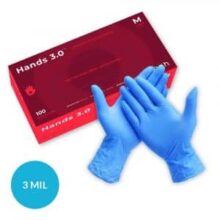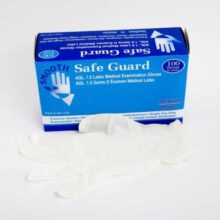Glove Dispenser with Belt Clip
Login For Health Care Pricing
In Stock
The Mueller Glove dispenser allows you to keep your medical gloves within easy reach and simplifies switching gloves when needed to treat a new patient.

Sports medicine encompasses a wide range of medical practices dedicated to preventing, diagnosing, and treating sports-related injuries. Within this field, healthcare professionals rely on a variety of tools and protective gear to ensure safe and hygienic practices. Among the most critical pieces of equipment are medical exam gloves, which play an essential role in maintaining the health and well-being of both athletes and medical personnel.
In this article, we will explore the significance of medical exam gloves in sports medicine and their various applications.
One of the primary roles of medical exam gloves in sports medicine is to prevent the transmission of infectious agents. Athletes are susceptible to cuts, abrasions, and open wounds during sports activities, increasing the risk of infection. Medical exam gloves act as a barrier between the healthcare provider’s hands and the patient’s body fluids, reducing the potential for cross-contamination. By wearing gloves, medical professionals can protect themselves and athletes from potential pathogens, including bacteria, viruses, and fungi.
In sports medicine, the prompt and proper management of wounds is crucial to ensure optimal healing and prevent complications. Medical exam gloves are used during wound assessment, cleaning, and dressing changes to maintain a sterile environment. By wearing gloves, healthcare professionals can minimize the introduction of foreign contaminants and bacteria into the wound, reducing the risk of infection and promoting a favorable healing environment.
Sports medicine often involves diagnostic procedures, such as physical examinations, joint assessments, and injury evaluations. Medical exam gloves are an integral part of these procedures, allowing medical professionals to perform tactile assessments and palpations while maintaining cleanliness and hygiene. Gloves provide a barrier between the examiner’s hands and the patient’s skin, ensuring a safe and sanitary environment during these evaluations.
Sports-related injuries often require the application of topical medications, such as ointments, creams, or gels, to facilitate healing or alleviate symptoms. Medical exam gloves are utilized during the application process to ensure accurate and controlled administration while preventing contamination. Gloves not only protect the patient from potential irritants but also shield the healthcare provider’s skin from absorbing medication that may cause adverse reactions.
In more complex cases, sports medicine may involve sterile procedures, such as joint aspirations, injections, or surgical interventions. Medical exam gloves are an indispensable component of maintaining a sterile field during these procedures. Sterile gloves are used to prevent the introduction of microorganisms into the patient’s body, minimizing the risk of surgical site infections or complications. The use of gloves in sterile procedures also protects healthcare professionals from direct contact with bodily fluids and potential bloodborne pathogens.
Medical exam gloves play a vital role in ensuring safe and hygienic practices in sports medicine. These gloves serve as a protective barrier, preventing the transmission of infectious agents, maintaining a sterile environment during procedures, and facilitating proper wound management. They are indispensable tools in the prevention of infections and cross-contamination, benefiting both athletes and healthcare providers alike. As sports medicine continues to evolve, the proper use of medical exam gloves will remain an essential aspect of providing effective and safe care to athletes of all levels.
Medical Exam Gloves are important supplies for your clinic and can help to protect both your staff and your patients from communicable illnesses. However, medical gloves can also be used for a variety of additional purposes outside the healthcare field that have nothing to do with medical procedures.
Exam gloves are useful to workers in several other applications besides healthcare. These include:
Healthcare workers in the dental, hospital and other industries in which there is potential contact with the bodily fluids of a patient will find these gloves useful to avoid the risks of contracting possible infections from their patients. The protection of the patients (especially to those who are immuno-compromised) from infection by their caregivers is also important.
Workers responsible for caring for the residents of senior living facilities will also find medical exam gloves important to protecting the residents, many of whom may be immuno compromised.
In many healthcare facilities, there is also a potential cross contamination risk, since a single health care worker may have contact with several patients over the space of a few hours.
However, the ability to quickly and easily change medical exam gloves between patients effectively eliminates the risk that bacteria and other pathogens that may have collected on them when treating one patient can then be transferred to another.
Medical exam gloves are also single use, which means that they cannot be reworn once they have been used. This feature also helps to limit the risk of cross contamination.
Workers who are responsible for analyzing blood, urine and other samples to look for evidence of viral or bacterial infection will also value the protection they receive from medical exam gloves. In many cases, these workers may be working with especially dangerous pathogens like HIV and the protection afforded by medical exam gloves can help to prevent a simple accident turning into a major crisis.
This is another setting in which the risk of cross contamination is an ever present concern. However, by disposing of the gloves after they have finished working with each specimen, laboratory workers can effectively eliminate the risk that contaminatory agents from one specimen can be transferred to another.
These gloves can be worn by workers in restaurants and other facilities responsible for food preparation. In this setting, they will help protect the food being prepared from possible contamination due to bacteria or pathogens that may be present on the hands of those preparing or serving the food.
Workers responsible for janitorial services to households or other facilities can use medical exam gloves to protect themselves from the risk of contamination, especially when cleaning areas like bathrooms and kitchens.
Medical exam gloves can also be a valuable protective accessory in times when there is a risk of contact with dangerous pathogens outside a hospital, lab or other medical facility.
For example, when dealing with the emergence of a virus such as that responsible for Covid-19 disease, members of the public can use these gloves for personal protection when carrying out chores when they may touch objects that have already been handled by (many) others.
Examples of these situations include using the grocery carts in a supermarket or handling the pumps in a gas station.
There are several design options available when purchasing exam gloves:
It is important to appreciate that there is no universally superior choice where these options are concerned. Instead, it is more a matter of matching the strengths of each option to the priorities that apply to your situation.
To help you make your selection in this section, we have included some pointers below:
Latex gloves offer good barrier protection and are also close fitting and flexible. However, the increasing prevalence of latex allergies has seen a decrease in the popularity of this material in recent years. Instead, latex free alternatives such as nitrile or vinyl gloves are taking the place of natural rubber latex.
Nitrile gloves are made from a synthetic rubber like material and have become increasingly popular. Nitrile offers almost the same strength and flexibility as latex without the allergic risks.
Vinyl is an economic choice but offers less sensitivity and protection than either latex or nitrile.
A recent feature in the market for medical exam gloves has been the emergence of hybrid gloves that offer the best performance aspects of two materials. For example, hybrid vinyl/nitrile gloves such as the Tuff / HyTuff gloves will offer the feel of nitrile and the durability of vinyl at a relatively economical price.
As a result, there is little or no need for powdered gloves these days and powder free gloves have become increasingly popular.
For additional information on choosing the best medical exam gloves, please refer to our post on this subject.


Login For Health Care Pricing
In Stock
The Mueller Glove dispenser allows you to keep your medical gloves within easy reach and simplifies switching gloves when needed to treat a new patient.

Login For Health Care Pricing
In Stock
Wayne Safety blue vinyl medical exam gloves. Latex and powder free. Sold as 100/box.

Login For Health Care Pricing
Out of Stock
Similar to the Wayne Safety Tuff Nitrile Exam gloves, these gloves are powder free and are available in sizes small – x large. Sold in boxes of 100.

Login For Health Care Pricing
In Stock
Noah Nitrile Powder Free Exam gloves are easy on/off, high quality, non sterile, latex free and ambidextrous.


Login For Health Care Pricing
Out of Stock
Naturamed Powder Free Vinyl Examination Gloves come 200 per box and are single use, latex free, non sterile and ambidextrous.

Login For Health Care Pricing
Out of Stock
Lightly powdered latex gloves. Available in sizes small – x large, 100 gloves/box.

Login For Health Care Pricing
In Stock
Wayne Safety Tuff HyTuff Hybrid Vinyl/Nitrile Exam Gloves are latex free and powder free and offer superior protection and durabiity together with excellent sensitivity.

Login For Health Care Pricing
In Stock
Wayne Safety Tuff Nitrile Exam Gloves are 100% nitrile and latex free and offer superior protection together with excellent sensitivity.